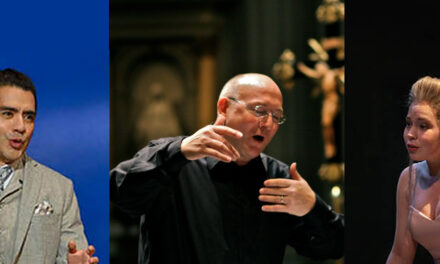As a special event prior to the beginning of the Highlands-Cashiers Chamber Music Festival, Timothy Albrecht and Mark Hughes presented their combined talents in a July 3 organ and trumpet concert in Highlands Presbyterian Church.
The program took an unusual twist when the trumpet part of the duo was still en route at curtain time. Highlands was as thronged as three in a bed; the main streets looked like a fairground. The winding narrow highways were also jammed, traveling at the speed of the slowest driver; no one seemed to be surprised at the no-show. So Albrecht jumped to one of his showcase pieces, Joseph Jongen’s Toccata (Moto Perpetuo). This piece, very much in the style of Cesar Franck, gave Albrecht an early opportunity to “pull out all the stops.” He handled the beginning flourishes and runs cleanly and with a nice sense of rhythmic flexibility within a larger framework of rock-solid rhythm. The earlier parts were dance-like, yielding to a big-chord cadence, and then tapering off nicely.
I had heard Albrecht’s three “grace notes” (“Hymn to Joy,”” Jesus Loves Me,” and “Shaker Tune”) exactly a year ago at the Porter Center in Brevard; upon second hearing, they were not quite so surprising but still nicely executed. Albrecht’s accompaniment to the “Hymn to Joy” is sophisticated and sprightly merry-go-round music. The cymbelstern of the Wicks organ in Highlands is not very successful; from my seat, it sounded like a cellphone. “Jesus Loves Me” is a pretty straight chorale-prelude with an accompaniment that has suspensions and repeated patterns in the style of the refrain to “Angels We Have Heard on High.” “Shaker Tune” begins with a nice acknowledgment of Brubeck’s “Take Five.” There was one place where Albrecht didn’t “come down right.” He came down wrong, on a manual set up with full organ for another piece. It was loud. But the piece is humorous enough that not a lot of damage was done.
By this time, Mark Hughes had arrived, and the printed program order was pretty much restored. In the same way that a “highbrow” formerly was one who could hear the William Tell Overture without thinking of the Lone Ranger, one must be stronger than I am to hear Mouret’s Rondeau without thinking of Masterpiece Theatre. Hughes’s modern trumpet was very smooth; he nicely varied the repeats. Albrecht and Hughes achieved excellent balance between trumpet and organ. The organ has rock-solid wind, sounding almost like a pre-digitally-sampled electronic.
Albinoni’s Concerto in D begins with a Grave that was exploited to the fullest by Hughes’s beautiful singing style. In the following Allegro, Hughes had minor problems with both intonation and precise entry, but once past the first couple of notes, his playing was superb. They took the Allegro at a brisk pace that pleased the crowd and had many tapping their toes. The Andante was again highlighted by Hughes’s incredibly smooth legato and his masterful handling of vibrato. The final Allegro had nice trumpet fanfares in alternation with the organ.
Bach’s Prelude and Fugue in a minor showed how totally dead the room was. Although musically unfortunate, this was instructive, for it showed how cleanly Albrecht plays and allowed a very careful study of the structure of the piece. Albrecht took both parts at a brisk tempo, with a nice rhythmic flexibility in the pedal part.
Mark Hughes chose Otto Ketting’s “Intrada for Trumpet” for one of his solos. The piece, demanding, seems perfect for Hughes’s legendary smooth legato. There is a long singing passage, then a jumpier, more typical trumpet sound, then more singing, followed by brisk fanfares and with dramatic use of rests and spaces.
Organ and trumpet paired in Ravel’s “Pavane,” a very successful arrangement. Although there was an occasional unsteadiness in the trumpet, overall the performance was superb, with excellent balance.
Albrecht’s own “grace note” on “Joy To The World” gave the audience pleasure and Hughes a chance to rest. The peppy and staccato piece is reminiscent of Handel’s “Pifa” in the Water Music.
Although not listed on the program, bravos and whistles saluted the completion of Widor’s warhorse Toccata, clearly well-appreciated in spite of the dead acoustics that made it a bit of a dud in the building. The upperwork of the organ is very shrill and does not blend with the rest of the plenum, but Albrecht’s playing redeemed things.
Hughes, suitably rested, performed three contemporary trumpet solos. Luciano Berio’s “Goodnight” is based on “Taps,” but with much wandering. Witold Lutoslawski’s “Tune” was tuneless. György Ligeti’s “The Big Turtle” was lots of fun.
Holst’s “I Vow to Thee, My Country” included organ sounds like a military band, a very smooth trumpet, brisk and precise entries, and full and legato organ sound. This, like the Widor, was also very well-received.
The listed pieces concluded with a Suite of [four] English Voluntaries by William Boyce. The first was veddy English, then surprisingly fiery; Albrecht was skillful in getting English organ sound out of the Wicks. The second, a slow organ interlude, was played on eight- and four-foots only; the third, pure Boyce, featured a trumpet-like melody in the right hand and flute stops in the left. The final voluntary was Boyce and un-Boyce at the same time, with typical English harmonies and very florid melody.
To much applause, Hughes and Albrecht returned for an encore – the perfect encore for the weekend – “The Star-Spangled Banner.” The organ began with a phrase of “America the Beautiful”; when the trumpet entered with the first notes of the melody it brought everyone to their feet. The performance was reverent, patriotic, and musically superb, bringing hands over hearts and a tear to more than one eye.
For a list of all the HCCMF programs, click here [inactive 11/05].











